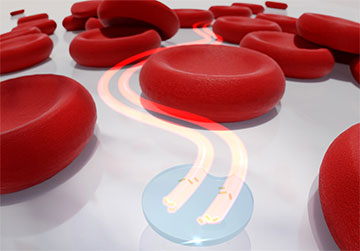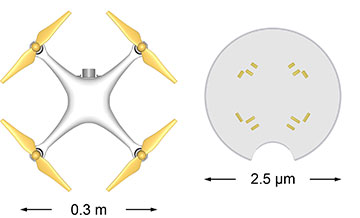
A team in Germany has developed microdrones, roughly a third the size of a human blood cell, that include two embedded plasmonic nanomotors that enable propulsion and navigation with light. [Image: Thorsten Feichtner, University of Würzburg]
From optical tweezers to solar sails, the power of photons to push microscopic, low-mass objects has long fascinated scientists and engineers. A team based in Germany has designed “microdrones” with motors fueled by unfocused near-infrared light fields (Nat. Nanotech., doi: 10.1038/s41565-022-01099-z).
The drones, each with a mass of roughly 2 picograms (pg), can move translationally and rotationally in a 2D water-based environment, and their creators control their paths by adjusting the optical power of the circularly polarized components of the light falling onto the drones’ motors. The scientists say that their invention offers new possibilities for building structures or analyzing surfaces at the nanoscale.
How to build a microdrone
Led by experimental physicist Bert Hecht, the scientists at the University of Würzburg, Germany, took as their inspiration a macroscopic “quadcopter,” a 30-cm-wide drone with four orthogonally mounted rotor blades. Instead of looking like a large plus sign from above, though, the microdrone is a thin, transparent polymer disc 2.5 μm in diameter decorated with several embedded gold rod-shaped objects. (A notch on one side of the disc helps distinguish “front” and “back.”)

One inspiration for the microdrones was the familiar macroscopic quadcopter. [Image: Xiaofei Wu, University of Würzburg]
The gold rods are, in fact, components of plasmonic nanomotors—groups of three, with one rod perpendicular to the other two. In the first type of motor, the orthogonal rod is situated between the other two rods; in the second type, the orthogonal rod points away from the two parallel rods.
According to the Würzburg team, the first type of motor produces thrust in opposite directions when hit by both types of circularly polarized light, creating resonant excitations. The second type of motor, however, generates thrust only with clockwise (CW) polarized light – and no thrust with light polarized in the counter-clockwise (CCW) direction. The team gave some of their drones two plasmonic motors and other drones four.
Navigation lesson
By varying the power levels of the CW and CCW components of the impinging 830- and 980-nm light, the researchers learned how to make the microdrones move forward, backward, left, right and in CW and CCW rotation while floating in a water bath. Even though the drones were one-third the size of a human red blood cell, the scientists could drive them in spiral and figure-eight paths.
The Würzburg team suggests that optimized microdrones could carry chemical cargos or manipulate tiny objects on a similar size scale. They could also perform sensing and scanning in a liquid environment or at a liquid-solid interface.
